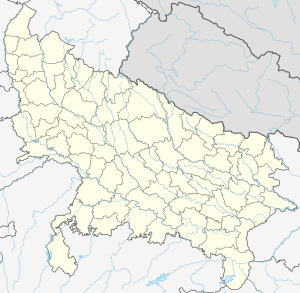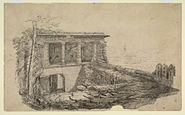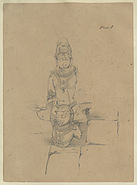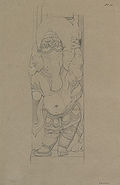| Kalinjr Fort | |
|---|---|
| Part of Banda district | |
| Uttar Pradesh, India | |
 A view of Kalinjar Fort | |
| Type | Fort, Caves & Temples |
| Site information | |
| Controlled by | Government of Uttar Pradesh |
| Open to the public | Yes |
| Condition | Ruined Citadel |
| Site history | |
| Built | 10th century |
| Materials | Granite Stones |
| Battles/wars | Mahmud of Ghazni 1023, Sher Shah Suri 1545, British 1812 & Revolt of 1857 |
| Garrison information | |
| Past commanders | Chandel dynasty of Rajputs & Solankis of Rewa |
| Garrison | British garrison 1947 |
| Kalinjar Fort Precincts Hanuman Darwaza|Kalinjar Fort|Laldarwaza |
|---|
Kalinjar(Hindi language: कालिंजर) is a fortress-city in the Bundelkhand region of central India. Kalinjar is located in Banda District of Uttar Pradesh state, near the temple-city and World Heritage Site of Khajuraho. The fortress is strategically located on an isolated rocky hill at the end the Vindhya Range, at an elevation of 1203 feet overlooking the plains of Bundelkhand. It served several of Bundelkhand's ruling dynasties, including the Chandela dynasty of Rajputs in the 10th century, and the Solankis of Rewa. The fortress contains several temples, dating as far back as the Gupta dynasty of the 3rd-5th centuries.
History[]
(Kalinjar) is one of the most characteristic specimens of the hill-fortresses, originally hill-shrines, of central India. Its antiquity is proved by its mention in the Mahabharata. Kalinjar means The destroyer of time in Sanskrit. 'Kal' is time and 'jar' destruction. Legend says that after manthan Hindu God, Lord Shiva, drank the poison and his throat became blue (hence the name Neel (blue) Kantha (throat)) and he came to Kalinjar and overcome the 'Kal' i.e. he achieved victory over death. This is the reason the Shiva temple at Kalinjar is called Neelkanth. Since then, the hill has been considered a holy site, casting its shadow across the patches of grasslands as well as the densely forested valley. The natural splendor of the surroundings makes it an ideal place for penance and meditation and, surprisingly, a strange mystique still pervades all over the hill.
The hilly peak has several legends attached to it. Its origin being shrouded in mystery, not much is known as to when and by whom the fort was built on this holy hill, though modern historians conjecture that Bargujar Kings built it from 150 to 250 CE. The fort contains Shiva temple of Neelkanth Mahadev. Similar to the one built by King Manthandev Bargujar,(a shilalekh/rock edict stands testimony to this fact,now inside Sariska Tiger Reserve ) confirmed by Col.James Tod in his classical, "Annals and Antiquties of Rajasthan" 18th century British historian,and at Baroli near Rana Sagar Dam. Later the Bargujars were part of a much bigger Gurjara–Pratihara Empire in North India which was at its peak from 500 to 1150 CE. The fort was a unique monument of its time and had no parallel in any other part of the country in terms of sheer grandeur and artistry.
Its historical background is replete with numerous battles and invasions. The Hindu princes of different dynasties as well as the Muslim rulers fought hard to conquer it and the fort continued to pass from one ruler to another. But, except for the Chandelas, no other ruler could reign over it for long,Chandelas are also a branch of the Bargujars called Chandela Rajputs.
It was besieged by Mahmud of Ghazni in 1023 without success, and later by the Mughal Babur who was the only commander in history to have captured the fort in 1526 when driving away Raja Hasan Khan Mewattpati. It was also the place where Sher Shah Suri met his death in 1545 when he was killed either in the fort or nearby on the grounds. Kalinjar played a prominent part in history down to the time of the Revolt of 1857, when it was held by a small British garrison. Both the fort and the town, which stands at the foot of the hill, are of interest to the antiquary on account of the remains of temples, sculptures, inscriptions and caves.
In 1812, the British troops marched into Bundelkhand. After a long battle they were able to annex the fort. The British seizure of Kalinjar proved to be a great watershed, transferring the legacy of the old aristocracy into the hands of the new bureaucracy of officials who showed their loyalty to British imperialism by damaging the captured fort. The damages caused to the fort can still be seen on its walls and open spaces.
Attractions[]
The majesty and grandeur witnessed within Kalinjar's precincts is due to the Bargujar rulers' creative imagination, their highly developed aesthetic sense and religious fervor. Though they were great devotees of Lord Shiva, they evinced a great interest in the construction of temples of other deities, too. The massive rock cut sculptures include figures of various gods and goddesses from ancient mythological themes. Wherever the Bargujar had established their reign they left their mark by enriching them with fine works of art, stone images, and sculpture.
The western part of the fort rewards all who take the time to look inside the temple of Neelkanth Mahadev. Each time one peeps through a cave-like opening and glances at an imposing Shivlinga of around five feet, one is awe-struck. The idea has been to use landscape and cave-isolation to set the solemnity of the mood for prayer. Its intrinsic feature is to reflect and refract light in the appropriate seasons, letting in light in winter and darkening to restrict its entry in summer. Just above the temple is a natural water source and water in this source never dries up. Water continually drips on Shivalinga. The priests, who are Chandela Rajputs since the time of the Chandela kings, point out an interesting factoid: The neck of the sculpture of lord shiva on the shivalinga, though made of solid rock, is always moist to touch. In some sense reminding every visitor the "neelkantha" or drinking of poison story.
Close to the Shivling cave, stand the idols of Bhairava and goddess Parvati, made of black stone. Images of numerous gods and goddesses are carved on both sides of the gateway. A number of broken pillars are seen at regular distances. On these pillars, it is said, six-storey constructions were raised, but they were demolished later. There are numerous rock-cut sculptures showing neglect and ravages of time. The vagaries of nature and of man have taken their toll but the remnants indicate a synthesis of several ancient cultures and faiths, the legacy of a glorious past.
Another beautiful sight is the palace of prince Aman Singh. He was the descendant of King Chhatrasal. A number of legends are associated with this Mahal whose big lawns and walls unfold a long history of Chandela culture. Thousands of images made of granite and sandstone have been collected in a museum set up informally. Rich carvings on these images arrest the eye, even though they are broken and have been struck by the ravages of time.
Trimurti images are also many, showing the faces of Brahma, Vishnu and Mahesh(Shiva). Some distance away is a massive figure of Vishnu lying in the ocean of milk, enclosed within the coils of the Sheshnag. It presents a unique artistic charm. The presence of images of Lord Shiva the god of love Kamadev, Indrani the wife of Indra etc. speaks of influence from diverse cultures and religions. It also leads us to believe that the creation of the Chandela culture was not the handiwork of artists from one region.
The Bargujar princes who ruled before the Chandelas were influenced by the 'Shaiva' cult. Therefore, among the rock-cut and stone images are mostly those of Shiva, Parvati, Nandi and the Shivling. Shiva is seen at times in his dancing posture of tandava and at others in a close embrace with goddess Parvati.
There are numerous other attractions. The Venkat Bihari temple presents a majestic look from the outside though its interiors are decayed now. Persons suffering from skin diseases can take a dip in the 'pond of million tirthas'. The Sita-kund, Pandu-kund, Patal-ganga etc. speak for the Chandelas' taste for the aquatic resorts.
Cemented roads have been built all through the mountainous passage along which people can conveniently travel to reach the fort. But to discover the real charm and pleasure of adventure, one has to walk along the old beaten track, making way through the rough and rocky terrain of the seven magnificent gates falling in between. Seeing these gates, one truly appreciates the functional relevance of this invincible fort and its strategic defenses.
How to reach[]
- BY AIR - The nearest airport is at Khajuraho, which is 130 km away.
- BY RAIL - The nearest railway station is Atarra 36 km away, on the Banda-Satna route, 57 km from the Banda railway station.
- BY ROAD - The Kalinjar fort is linked by road to all the important centres in the region with regular bus services. Some of the major road distances are: Chitrakoot, 78 km; Banda, 62 km; Khajuraho, 130 km; and Allahabad, 205 km.
Gallery[]
External links[]
| ||||||||||||||||||||||||||||||||||||||||||||||||||||||||||||||
| |||||
The original article can be found at Kalinjar Fort and the edit history here.






